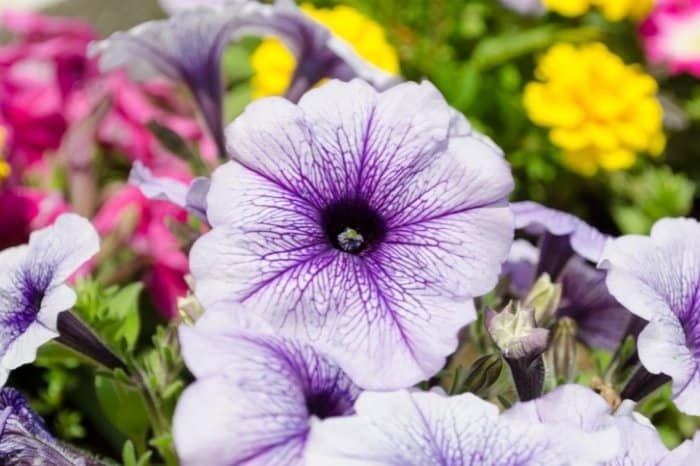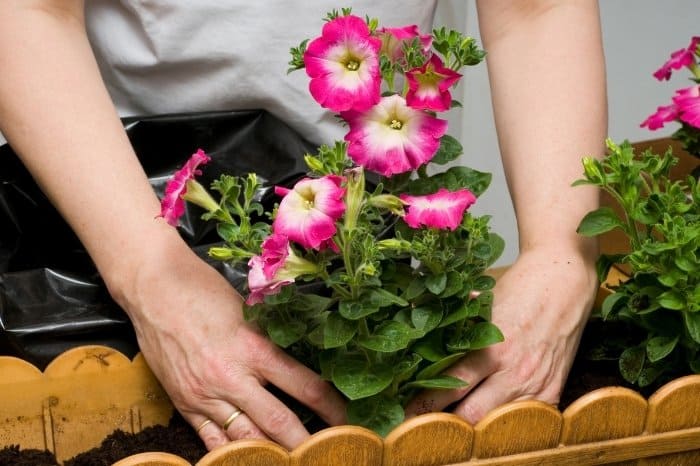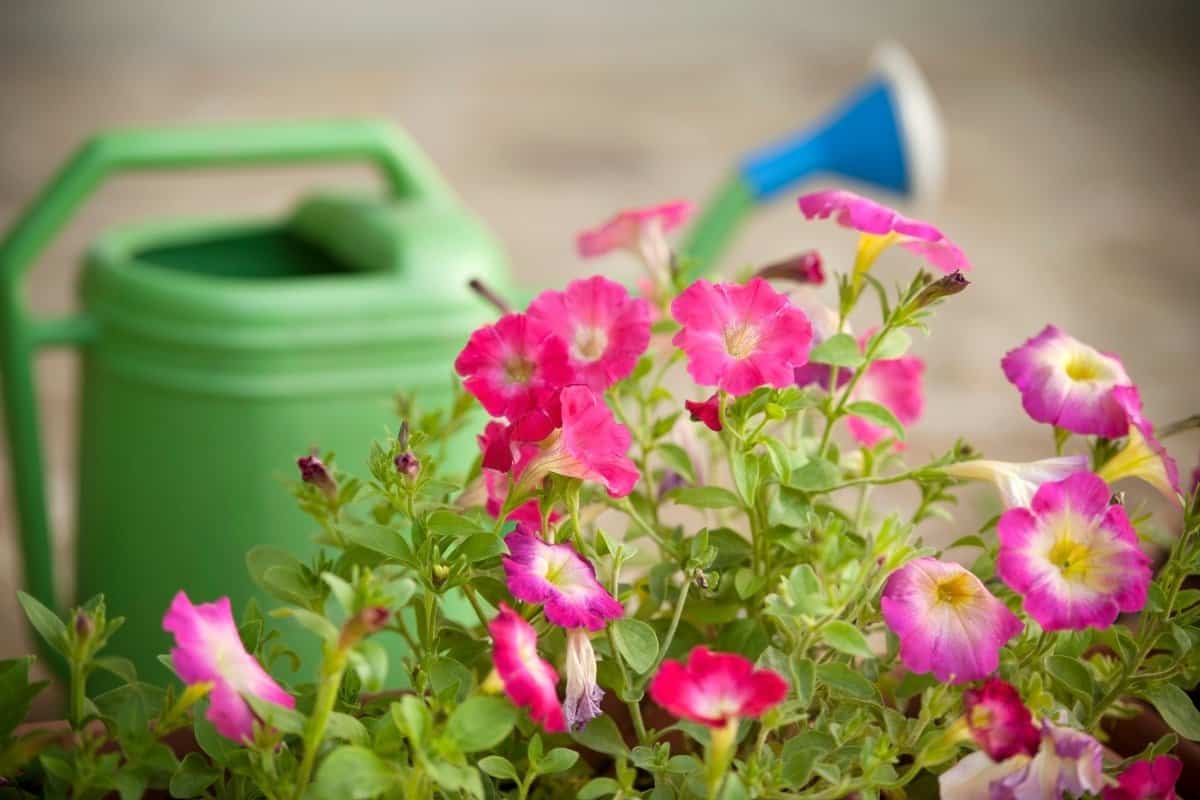Last Updated on February 7, 2022 by
How often to water petunias is a question asked by most gardeners and we are going to address it extensively in this article.
Growing petunias is easy and requires less work compared to other types of flowers. It is not surprising that petunias are a favourite among many gardeners, and they come in a wide range of colours. These flowers bloom all summer with non-stop flowers.
Petunias can grow in beds, borders, hanging baskets, and containers. If you are not sure what to plant in your hanging baskets, go for petunia plants. They require only a bit of effort, and they will reward you with lots of bright coloured blooms.
Facts About Petunias
- Petunias are treated as annuals in most areas but grow as tender perennials in USDA zones 9 to 11.
These flowers come in many patterns and colours, blooming from spring until frost! - These colourful annual flowers can really add a pop of colour to a front lawn.
- They are often used in containers, borders, hanging baskets or even as a seasonal groundcover. Some flowers even have a slight fragrance.
- Their height can vary from 6 to 18 inches, with a width of 18 inches to 4 feet.

How Often To Water Petunias
One of the commonly asked questions about petunias growing in hanging baskets is how often to water.
The answer is straightforward – watering petunias should be done when the top inch of your soil feels dry when you stick your finger in it.
Petunia water requirements will most likely require water daily during the summer, and maybe even twice when it’s scorching or with a strong wind.
Give your plant plenty of water so that the excess drips out of the drain hole. Never leave the soil to remain continually wet; you will be subjecting your petunia roots to rot in such a soggy condition. If possible, water the soil, not the leaves to avoid fungal infection.
Feeding Petunias With Water-Soluble Fertilizers
Petunias require feeding every week using a water-soluble fertilizer for flowering annuals. These flowers are heavy feeders because they grow at a faster rate and produce many flowers.
You can use a diluted fertilizer solution daily as you water your plants. Be sure to allow the water to drip until the drain hole pours. Watering this way does not mean you are flushing out nutrients, as you would do when using plain water.
J R Peters Inc 52624 Jacks Classic No.1.5 20-6-22 Petunia Feed
Sunlight Requirement Plus Amount Of Water To Give Petunias
How much water do petunias need depends on the amount of sunlight you give your plants. Adequate sun is an essential requirement for successful growth. They require at least 5 to 6 hours of sunlight but will perform even better if they are under full sunlight all day long.
The more shade they are in, the fewer blooms they produce. If your basket is hanging under a porch, ensure that you rotate your basket of flowers each week so the dark side can get some sun.
You should remove wilted flowers as soon as they fade; otherwise, they will go to seed and stop blooming early. Removing the wilted flowers also makes the plant look nicer.
Do You Prune Petunias?
Yes, it is advisable to prune your petunias. Petunias produce blooms at the tip of each branch. Branches continue being longer as summer progresses and have more flowerless greenery.
Pruning them provides them new tips where more flowers will bloom in hanging baskets. When pruning, cut each stem back by about 1/3 to ½ when they start looking tired and faded in midsummer. Pruning rejuvenates them, and a new burst of blooms are born.
Choosing Petunia Variety To Grow
When growing petunias, it is wise to choose a variety togrow in pots or flowerbeds. Let’s look at the different varieties.
- Multiflora Varieties – these are big bloomers with 2-inch flowers; they are compact and require minimal pinching.
- Grandifloras – They have very showy 5-inch blooms. However, they have fewer flowers than the Multiflora variety. Most of them measure 12-15 inches tall and have a trailing habit.
- Floribundas – These are a cross between Grandiflora and Multiflora with big flowers and ease of care like the Multiflora variety.
- Millifloras – They have small 1-inch flowers and are best for containers and hanging baskets as they only get 8 inches tall.
Buying Petunia Plants For Your Garden
Instead of seeding your own, it’s easier to buy petunias to plant in your garden most of the time.
At the garden centre, look for plants that have only a few open flowers and a few buds. Buy these plants when they are green so they can continue growing. The smaller the plant, the best time to bring it home and the better it will take off growing.
Don’t buy a plant that has stringy foliage around the edges of the pot, and avoid a plant that has a floppy neck. Look for a plant that is sturdy and strong, tight, and compact.

Petunias In Hanging Baskets
Petunias are perfect for hanging baskets, especially those at the porch, entrances or doors. They love the sun, so be sure you expose them to as much sun as possible by choosing a location that receives about 6 hours of sun daily.
When planting your petunias in a hanging basket, look for varieties that produce long blooms on long flowing stems. As long as you have a sturdy pot with at least one drainage hole, the container fits your plants.
Fill the container with a lightweight commercial potting mix that promotes proper drainage. Never use garden soil in your hanging baskets as it will be too heavy for your plants and proper drainage.
Garden soil easily becomes compacted and too heavy for proper drainage. Mix a slow-release fertilizer into the potting soil during planting time to allow feeding of the plant as it grows.
FAQs
Do petunias need to be watered daily?
Petunias need regular waterings to stay healthy and happy. The key is that they are thirsty, so you can’t just sprinkle them with a hose or mist them in the morning. You must give them a good soaking during the day and then let them dry out overnight.If you don’t, they will be much more prone to disease.
Can you overwater petunias?
If you watered them thoroughly, then yes, you could overwater them.
How do you tell if petunias are overwatered?
The stems are not wilted but rather drooping, which is what you will see when the plant is in direct sun. It is a sign of too much water and the leaves have lost their vibrant green color. The blooms may appear to be drooping as well. If this is the case, reduce the watering.
How do you revive Overwatered petunias?
You can try adding some fresh compost or potting soil into the pot.This will help keep the soil moist and will allow for good root growth.
What is the best time of day to water petunias?
The best time of day for watering your plants is when they are most active. This means in the morning or evening. It is best to water plants during their active period. If you water a plant at night or early in the morning, it may not be able to soak up the water and can end up with root rot.
Why is my petunia dying?
The first thing to consider is what you feed them. Do they have access to good soil and fertilizer? Is their soil heavy or light? Are the roots in good condition? Do they have good air circulation? Are they getting enough light? Do you fertilize regularly?
How long do petunias last?
Petunias are one of the easiest plants to grow, and they will last for years. Petunias are extremely versatile, growing in sun or shade, with soil that is not too rich or too poor, and can be used as cut flowers or potted plants.
The common petunia is a large-flowered plant that produces a profusion of red, pink, or white blooms on long stems. There are many other colors and varieties, including some with single flowers.
Petunias are herbaceous perennials, growing from a thick tap root, which makes them hardy in Zones 10 through 12.
Petunias have large, bright blooms that open up in the summer, and can grow as tall as 2 feet.
Growers also should keep in mind that petunias are sensitive to cold temperatures. When you plant your petunias outdoors, cover them with a few inches of mulch or soil to help them through the winter months. Fertilize your petunias regularly, especially during the spring, according to the National Garden Bureau.
How long do petunias last in hanging baskets?
Petunias and other hanging plants can be expected to live for approximately one or two years, according to the National Garden Bureau. They should last 2-3 years.
Conclusion
FAQs
Do petunias need to be watered daily?
Petunias need regular waterings to stay healthy and happy. The key is that they are thirsty, so you can’t just sprinkle them with a hose or mist them in the morning. You must give them a good soaking during the day and then let them dry out overnight.If you don’t, they will be much more prone to disease.
Can you overwater petunias?
If you watered them thoroughly, then yes, you could overwater them.
How do you tell if petunias are overwatered?
The stems are not wilted but rather drooping, which is what you will see when the plant is in direct sun. It is a sign of too much water and the leaves have lost their vibrant green color. The blooms may appear to be drooping as well. If this is the case, reduce the watering.
How do you revive Overwatered petunias?
You can try adding some fresh compost or potting soil into the pot.This will help keep the soil moist and will allow for good root growth.
What is the best time of day to water petunias?
The best time of day for watering your plants is when they are most active. This means in the morning or evening. It is best to water plants during their active period. If you water a plant at night or early in the morning, it may not be able to soak up the water and can end up with root rot.
Why is my petunia dying?
The first thing to consider is what you feed them. Do they have access to good soil and fertilizer? Is their soil heavy or light? Are the roots in good condition? Do they have good air circulation? Are they getting enough light? Do you fertilize regularly?
How long do petunias last?
Petunias are one of the easiest plants to grow, and they will last for years. Petunias are extremely versatile, growing in sun or shade, with soil that is not too rich or too poor, and can be used as cut flowers or potted plants.
The common petunia is a large-flowered plant that produces a profusion of red, pink, or white blooms on long stems. There are many other colors and varieties, including some with single flowers.
Petunias are herbaceous perennials, growing from a thick tap root, which makes them hardy in Zones 10 through 12.
Petunias have large, bright blooms that open up in the summer, and can grow as tall as 2 feet.
Growers also should keep in mind that petunias are sensitive to cold temperatures. When you plant your petunias outdoors, cover them with a few inches of mulch or soil to help them through the winter months. Fertilize your petunias regularly, especially during the spring, according to the National Garden Bureau.
How long do petunias last in hanging baskets?
Petunias and other hanging plants can be expected to live for approximately one or two years, according to the National Garden Bureau. They should last 2-3 years.
It is not surprising that petunias are a favourite for generations. Their wide range of colours and their bloom for all summer with non-stop flowers make these annuals or perennials a favourite.
Planting these flowers is easy, and you can give themproper care easily. Anyone can grow them, even newbies. No much experience is needed except some information from such articles we are providing you with.
You can plant petunias in beds, borders, hanging baskets and containers. Happy petunias gardening!
Caroline is a gardener who loves to get down to the nitty–gritty of gardening. She proudly proclaims herself as a ‘dirt worshipper‘ and can often be found deep in the garden, covered in soil and singing to her plants. As a self–proclaimed ‘plant whisperer‘, Caroline believes that plants need love and attention just like any other living thing, and she loves to give them both. When she‘s not tending to her garden, you can often find her researching the latest gardening trends, or teaching others how to make their gardens thrive


